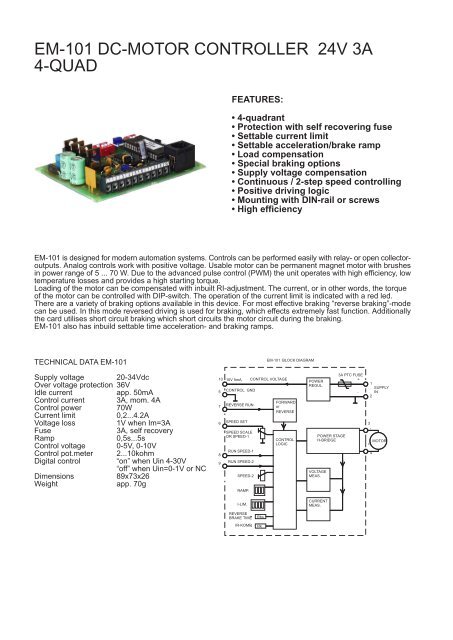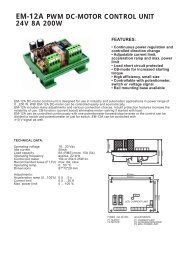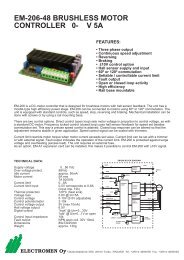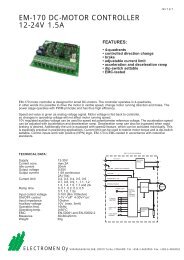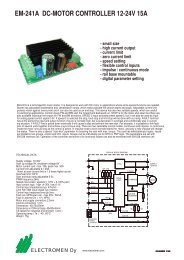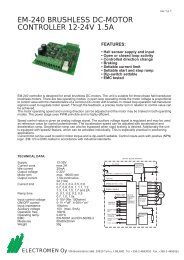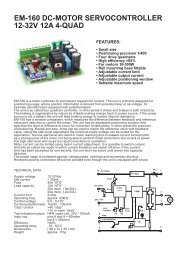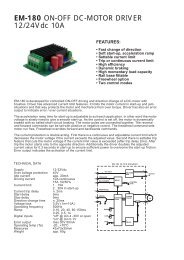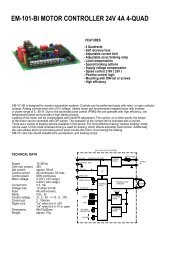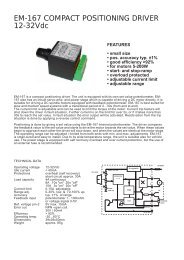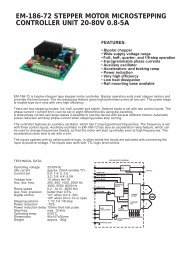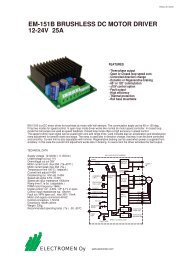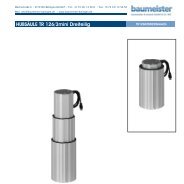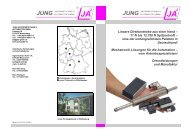EM-101 DC-MOTOR CONTROLLER 24V 3A 4-QUAD - Electromen
EM-101 DC-MOTOR CONTROLLER 24V 3A 4-QUAD - Electromen
EM-101 DC-MOTOR CONTROLLER 24V 3A 4-QUAD - Electromen
- No tags were found...
You also want an ePaper? Increase the reach of your titles
YUMPU automatically turns print PDFs into web optimized ePapers that Google loves.
<strong>EM</strong>-<strong>101</strong> <strong>DC</strong>-<strong>MOTOR</strong> <strong>CONTROLLER</strong> <strong>24V</strong> <strong>3A</strong>4-<strong>QUAD</strong>FEATURES:• 4-quadrant• Protection with self recovering fuse• Settable current limit• Settable acceleration/brake ramp• Load compensation• Special braking options• Supply voltage compensation• Continuous / 2-step speed controlling• Positive driving logic• Mounting with DIN-rail or screws• High efficiency<strong>EM</strong>-<strong>101</strong> is designed for modern automation systems. Controls can be performed easily with relay- or open collectoroutputs.Analog controls work with positive voltage. Usable motor can be permanent magnet motor with brushesin power range of 5 ... 70 W. Due to the advanced pulse control (PWM) the unit operates with high efficiency, lowtemperature losses and provides a high starting torque.Loading of the motor can be compensated with inbuilt RI-adjustment. The current, or in other words, the torqueof the motor can be controlled with DIP-switch. The operation of the current limit is indicated with a red led.There are a variety of braking options available in this device. For most effective braking “reverse braking”-modecan be used. In this mode reversed driving is used for braking, which effects extremely fast function. Additionallythe card utilises short circuit braking which short circuits the motor circuit during the braking.<strong>EM</strong>-<strong>101</strong> also has inbuild settable time acceleration- and braking ramps.TECHNICAL DATA <strong>EM</strong>-<strong>101</strong><strong>EM</strong>-<strong>101</strong> BLOCK DIAGRAMSupply voltage 20-34VdcOver voltage protection 36VIdle currentapp. 50mAControl current <strong>3A</strong>, mom. 4AControl power 70WCurrent limit0,2...4.2AVoltage loss1V when Im=<strong>3A</strong>Fuse<strong>3A</strong>, self recoveryRamp0,5s...5sControl voltage 0-5V, 0-10VControl pot.meter 2...10kohmDigital control “on” when Uin 4-30V“off” when Uin=0-1V or NCDimensions89x73x26Weightapp. 70g10 10V 5mA57689CONTROL GNDREVERSE RUNSPEED SETSPEED SCALEOR SPEED-1RUN SPEED-1RUN SPEED-2SPEED-2RAMP.CONTROL VOLTAGEFORWARDorREVERSECONTROLLOGICPOWERREGUL.POWER STAGEH-BRIDGEVOLTAG<strong>EM</strong>EAS.<strong>3A</strong> PTC FUSE+-1SUPPLYIN23-<strong>MOTOR</strong>+4I-LIM.CURRENTMEAS.REVERSEBRAKE TIMEIR-KOMP.RbsRk
<strong>EM</strong>-<strong>101</strong> INSTRUCTIONSSupply voltage must be <strong>DC</strong> with ripple less than 20%. Supplyvoltage 20...34V ( 26...32V recommended ). In the beginningset all trimmers in the middle position.NOTE! When reversed braking is used the controller will takea very high current peak. Capacitor for the power supplyshould be at least 4700uF at 1A.1+CrPOWERSOURCE2-3 4- +<strong>MOTOR</strong>89 mmCONNECTORS:73 mmFUSET<strong>3A</strong>ONOFFSPEED-1 /POT. RANGE1 2 3 4CURRENTLIMITP1P2SPEED2RbsCOMPENSATION Rk123RAMPMODULAR-6ONOFF66 mm1. Supply voltage 20-34Vdc2. Supply voltage GND 0V3. Motor (-)4. Motor (+)5. Control GND6. Controlling voltage7. Reverse/driving direction8. Run speed1 (potentiometer)9. Run speed210. Helping voltage for potentiometer ( 10V, 5mA )THE CURRENT LIMITLimitation of the current ( torque )Controlled with DIP-switcheson11 2 323 44 5 6 7 8 9 100A0.2A0.5A0.9A1.2A1.5A1.8A2.0ATHE COMPENSATION82 mm12342.<strong>3A</strong>2.6A2.9A3.1A3.4A3.7A4.0A4.2AWith compensation you can compensate the loadeffect to motor rpm. This feature increases controllingif current increases in the motor circuit. The needfor compensation depends on application and motor.Typically small motors require more compensationthan big ones. Over compensation occurs as twichingof the motor.Example:The smaller resistor the bigger compensation.Typical settings: motor < 10W Rk= 50...500ohmmotor > 10W Rk= 200...2000ohmMODULAR-6 CONNECTORRun speed2Run speed1 (potentiometer)Helping voltage for potentiometer ( 10V, 5mA )Reverse start/driving directionControling voltageControl GND OVTHE RAMP & BRAKINGIn the map below the first two ramp settings are specialbraking options. The first position is so called reversebraking; the motor is controlled in opposite direction.Reverse braking time is set with resistor (rbs). The secondposition is so called short circuit braking where the motorcircuit is short circuited during the braking. Other positionsare for normal acceleration and braking settings which areset with DIP-switches.1 2 3on Opposite control braking, no rampTHE CONTROLLINGThe max value of controlling voltage ranges 5...10V. Thefull range is thus maintained on 0...5V. The range can beset with trim P1. When driving with double speed controlling( run / set ) the driving speed is set with trim P1 and thesetting speed with trim P2.P1 100% range 0-10V (0...100%)50%0%Short circuit braking, no ramp0,5s. Ramp1s. Ramp2s. Ramp3s. Ramp4s. Ramp5s. Ramprange 0-5V (0...100%)P2REVERSE BRAKING TIMESET RESISTORt(ms) = (256 x Rbs) / (Rbs + 10kohm)Rbs max. 10 kohm. ( t = 256ms )Rbst min. 0,1kohm. ( t = n. 3ms )0%50%100%
<strong>EM</strong>-<strong>101</strong> CONNECTION EXAMPLESDirection change/reverse drive.Direction change/reverse drivewith voltage.Speed adjustment with pot.meter.Range scaling with trim P1.5 6 7 8 9 105 6 7 8 9 105 6 7 8 9 10Speed control with pot.meter,activate with run speed1-switch.U-cont. forward 0...1VBackward 4...30VSpeed control with voltagesignal.Range scale with trim P1.Double speed control.Speeds set with trimmersP2 (s2, pin9) and P1(s1,pin6)Activate with switches.5 6 7 8 9 105 6 7 8 9 105 6 7 8 9 10U-cont. 0-5V --> 0-10VELECTROMEN Oy Vähäheikkiläntie 56B, 20810 Turku, FINLAND Tel. +358-2-4693050 Fax. +358-2-4693052


